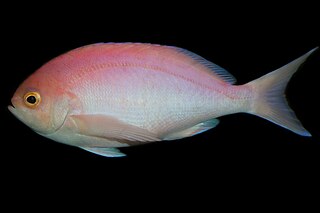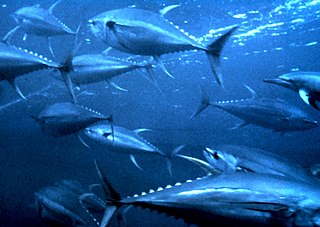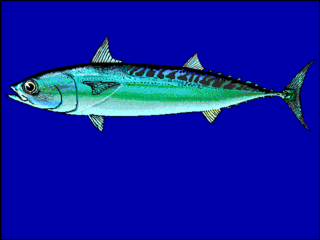
A tuna is a saltwater fish that belongs to the tribe Thunnini, a subgrouping of the Scombridae (mackerel) family. The Thunnini comprise 15 species across five genera, the sizes of which vary greatly, ranging from the bullet tuna up to the Atlantic bluefin tuna, which averages 2 m (6.6 ft) and is believed to live up to 50 years.

Mackerel is a common name applied to a number of different species of pelagic fish, mostly from the family Scombridae. They are found in both temperate and tropical seas, mostly living along the coast or offshore in the oceanic environment.

Herring are forage fish, mostly belonging to the family of Clupeidae.

The yellowfin tuna is a species of tuna found in pelagic waters of tropical and subtropical oceans worldwide.

The double-lined mackerel, is a species of Spanish mackerel in the family Scombridae. This species is sometimes also called the scad mackerel.

Pelagic fish live in the pelagic zone of ocean or lake waters—being neither close to the bottom nor near the shore—in contrast with demersal fish that live on or near the bottom, and reef fish that are associated with coral reefs.

The sharpnose sevengill shark, also known as one-finned shark, perlon shark, sevengill cow shark, sharpsnouted sevengill or slender sevengill, is a species of shark in the family Hexanchidae, and the only living species in the genus Heptranchias. Found almost circumglobally in deep water, it is one of the few species of sharks with seven pairs of gill slits as opposed to the usual five. The other shark species with seven gill slits is the broadnose sevengill shark. Though small, this shark is an active, voracious predator of invertebrates and fish. When caught, this species is notably defensive and will attempt to bite. It is of minor commercial importance.

The Atlantic bonito is a large mackerel-like fish of the family Scombridae. It is common in shallow waters of the Atlantic Ocean, the Mediterranean Sea, and the Black Sea, where it is an important commercial and game fish.

Emmelichthys nitidus, the Cape bonnetmouth, bonnetmouth, redbait, pearl fish, picarel, red baitfish, red herring or Southern rover, is a species of marine ray-finned fish belonging to the family Emmelichthyidae, the rovers and bonnetmouths. This species is found in the Indian and Pacific oceans. This species is of minor importance to commercial fisheries.

The pink maomao, also known as the longfin perch, is a species of marine ray-finned fish, a member of the subfamily Anthiinae which is part of the grouper and sea bass family Serranidae. It is found in the southern Pacific and the southeastern Indian Ocean.

Thunnus is a genus of ocean-dwelling, ray-finned bony fish from the mackerel family, Scombridae. More specifically, Thunnus is one of five genera which make up the tribe Thunnini – a tribe that is collectively known as the tunas. Also called the true tunas or real tunas, Thunnus consists of eight species of tuna, divided into two subgenera.

The little tunny, also known as the false albacore, little tuna, bonita, or erroneously as the blue bonito, is a species of tuna in the family Scombridae. It can be found in the Atlantic Ocean and the Mediterranean and Black seas; in the western Atlantic, it ranges from Brazil to the New England states. The little tunny is a pelagic fish that can be found regularly in both offshore and inshore waters, and it is classified as a highly migratory species. The little tunny is best identified by the "worm-like" markings on its back and the dark spots appearing between its pectoral and ventral fins.

The bayad, is a species of bagrid catfish from Africa.

The bullet tuna, Auxis rochei, is a species of tuna, in the family Scombridae, found circumglobally in tropical oceans, including the Mediterranean Sea, in open surface waters to depths of 50 m (164 ft). The population of bullet tuna in the Eastern Pacific was classified as a subspecies of A. rochei, A. rochei eudorax, but some authorities regard this as a valid species Auxis eudorax. Its maximum length is 50 centimetres (20 in).

Auxis is a genus of ocean-dwelling ray-finned bony fish in the family Scombridae, and tribe Thunnini, also known as the tunas. Auxis, commonly and collectively called the frigate tunas, is one of five genera of tunas which comprise the Thunnini tribe.

An anchovy is a small, common forage fish of the family Engraulidae. Most species are found in marine waters, but several will enter brackish water, and some in South America are restricted to fresh water.

Thunnus tonggol is a species of tuna of tropical Indo-West Pacific waters.

The slender fusilier is a species of marine ray-finned fish, a fusilier belonging to the family Caesionidae. It is native to tropical reefs in the Indian Ocean and the western Pacific Ocean, it is of minor importance to local commercial fisheries. This species is the only known member of its genus.

Taractichthys steindachneri, the sickle pomfret, is a species of marine ray-finned fish, a pomfret of the family Bramidae. It is found in the Indian and Pacific Oceans.
Scomberesox scombroides, the king gar, is a species of saury, a fish in the family Scomberesocidae which is widespread in the temperate oceans of the Southern Hemisphere. It is a slender, elongated fish which has a small mouth with long extensions of both jaws forming a beak with the extension of the lower jaw being slightly longer than that of the upper jaw, the dorsal and anal fins are set far back on the body and have short bases, each is followed by 5-7 finlets between them and the deeply forked homocercal tail.





















